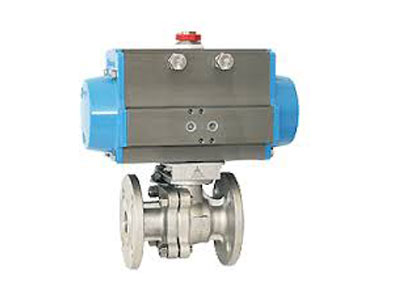Key Takeaway
A 3-way pneumatic valve is used to control air flow in three paths. It has three ports: an inlet, an outlet, and an exhaust. This valve can direct air to different paths or shut off the flow completely. It’s versatile, allowing systems to shift between different states.
For example, it can switch between pressurizing and exhausting a pneumatic cylinder. This flexibility makes 3-way valves popular in automation. They enhance system functionality by providing multiple control options. Understanding their operation helps in designing efficient pneumatic systems.
Introduction to 3-Way Pneumatic Valves
The 3-way pneumatic valve is a fundamental component in pneumatic systems, and its simplicity belies the critical role it plays in many industrial processes. It functions by controlling the direction of air flow through three different ports, each connected to different parts of the system. The valve can direct the compressed air to one of two outlets or, in some cases, block air flow entirely depending on the valve configuration.
This type of valve is typically used in systems where air flow needs to be either switched between two points or blocked temporarily. They are commonly found in systems that require the switching of air flow for actuators, cylinders, or other pneumatic devices, making them versatile tools in automation. A variety of 3-way valves exist, each tailored to different operational needs, but they all share the same essential function of controlling air flow in a system.
Whether it’s an on/off switch, a directional flow controller, or an exhaust valve, the 3-way pneumatic valve offers significant flexibility for a wide range of applications. Understanding the basics of how it works can help you optimize pneumatic systems for better performance and efficiency.

Design and Functionality of 3-Way Valves
The design of a 3-way pneumatic valve includes three distinct ports: an inlet port (P), an outlet port (A), and an exhaust port (B). These valves typically operate with two possible positions: one for directing the flow to the actuator and another to exhaust the air from the system. The valve’s spool moves within the housing, changing the connections between the inlet and the two outlet ports.
Position 1: In this position, air is directed from the inlet port (P) to the outlet port (A), while the exhaust port (B) is sealed.
Position 2: The air from the inlet port (P) is directed to the exhaust port (B), and outlet port (A) is sealed.
The versatility of the 3-way valve allows it to serve multiple purposes, such as switching the air supply between two actuators, enabling or disabling air flow to a component, or even controlling the return of air from a cylinder. The key feature of a 3-way valve lies in its ability to alternate between different ports, giving it significant functionality in applications where alternating air supply is needed.
You May Like to Read
Applications of 3-Way Valves in Industrial Systems
3-way pneumatic valves have broad applications in various industries where compressed air is used to automate processes, control machinery, and operate pneumatic devices. Some common applications include:
Cylinder Control: 3-way valves are often used to control the movement of single-acting cylinders, where the valve directs air to either extend or retract the cylinder. By switching air flow between two outlets, the valve ensures smooth and controlled operation of cylinders in systems such as conveyors, presses, or robotic arms.
Air Flow Isolation: In complex pneumatic systems, 3-way valves are used to isolate certain components. When air is not needed in one part of the system, the valve can block off the flow to prevent waste and optimize the performance of other sections.
Exhausting Air: For applications where air must be released or vented from a component, such as actuators or pressure chambers, the 3-way valve is employed to release the air to the exhaust port. This ensures the safe and controlled venting of air when needed, such as in pressure relief or ventilation systems.
Flow Direction Control: In applications where air needs to be routed in two directions, such as diverting compressed air between different parts of a system, the 3-way valve provides the necessary flexibility.
Advantages of Using 3-Way Pneumatic Valves
The use of 3-way pneumatic valves offers numerous advantages in industrial systems, making them an attractive choice for engineers and technicians. Some of the key benefits include:
1. Compact Design: 3-way valves are compact and simple in design, allowing them to be used in space-constrained environments. Their small size means they can be easily integrated into various systems without taking up valuable space.
2. Cost-Effective: Due to their simplicity, 3-way valves are generally more affordable compared to more complex valves, making them a cost-effective solution for controlling air flow in industrial systems.
3. Versatility: A 3-way valve is highly versatile, capable of directing air to different parts of the system or cutting off the air supply entirely. This flexibility is valuable in systems where frequent changes in air routing are necessary.
4. Efficiency: By switching between air supply and exhaust ports, the 3-way valve ensures that compressed air is used efficiently, preventing unnecessary wastage and optimizing the system’s energy consumption.
Maintenance Tips for 3-Way Valves
To keep 3-way pneumatic valves functioning optimally, regular maintenance is essential. Proper care can ensure long-term reliability and reduce the likelihood of unexpected downtime. Here are some maintenance tips to consider:
1. Regular Inspections: It’s essential to inspect 3-way valves frequently for any signs of wear or damage. Check for leaks, corrosion, or loose connections that may affect the valve’s performance. Routine inspections will help identify potential problems early.
2. Clean the Valve: Dust, dirt, and debris can cause the valve to malfunction. Periodically clean the valve to prevent particles from obstructing the valve’s internal components. Use compressed air or a soft brush to remove dirt and keep the valve operating smoothly.
3. Lubrication: Apply appropriate lubrication to the valve’s moving parts, especially if the valve operates frequently or in harsh conditions. Lubrication reduces friction, preventing excessive wear and ensuring smooth valve operation.
4. Check Seals: Ensure that the seals around the valve are in good condition and free of cracks or wear. Worn seals can lead to leaks or compromised pressure control, which can affect the entire system.
5. Test for Leaks: After performing any maintenance or repairs, always test the valve for air leaks. Leaking valves can cause system inefficiencies and safety issues.
Conclusion
In conclusion, 3-way pneumatic valves are integral components in air systems that provide flexibility, efficiency, and reliability. Their ability to control the direction of air flow and isolate or exhaust air when necessary makes them indispensable in a variety of industrial applications, from controlling actuators to managing complex air flow systems.
By understanding the design, functionality, and applications of 3-way valves, as well as the maintenance tips for keeping them in top condition, engineers can maximize the performance of pneumatic systems. Properly selected and maintained 3-way pneumatic valves contribute to the overall efficiency, safety, and cost-effectiveness of industrial air systems, ensuring long-term reliability and smooth operation.
